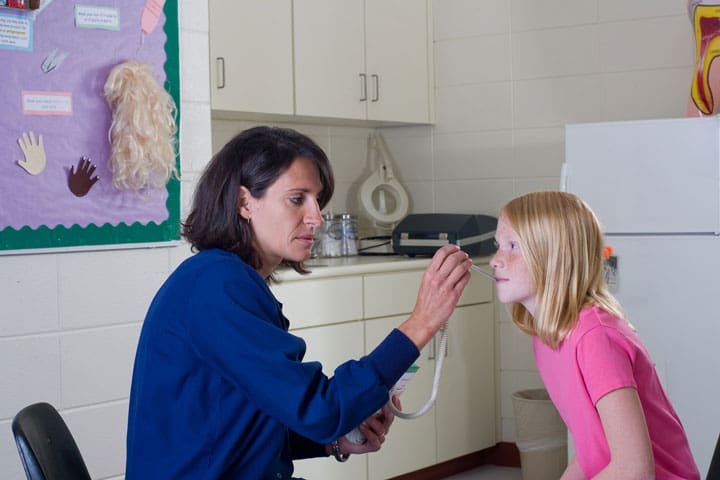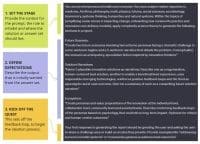Late one evening in the spring of 2019 Dr. Susan Hassmiller called to invite me to present to the Future of Nursing 2020-2030 committee that coming summer. Little did I understand the journey that one pivotal phone call would take me on over the next few years. To begin with, it took me from my Camden, New Jersey health office to the storied halls of Penn Nursing school for the Philadelphia Town Hall as part of the nationwide listening tour as the committee began its work. As a direct result of my presentation, my journey continued to Washington, D.C. where I was invited by Congresswoman Lauren Underwood to speak at a gun violence prevention press conference. Imagine all that can happen because of one late-night phone call.
My deepest appreciation to those trusted colleagues who helped me frame my remarks to the Future of Nursing (FON) Committee 2020-2030. I was allotted 15 minutes to share the scope and scale of school nursing along with providing futuring and visioning for what school nursing can be in the next ten years.
In the spirit of “Many hands make light work” I offer this special acknowledgment:
In addition to my presentation, school nursing leaders Drs. Robin Shannon and Katie Johnson provided public testimony at Town Halls in Chicago and Seattle during 2019 and generously shared their succinct comments with me. Jeanne Kiefner, Eileen Gavin, Laurie Combe, NASN Executive Committee, Donna Mazyck, Dr. Erin Maughan provided support, guidance and were sounding boards helping me to prepare a collective reflection of school nursing present and future. Special appreciation to Dr. Donna Nickitas, Dean of Rutgers Camden Nursing for reviewing my final draft. Barbara Glickstein, a dear friend, a trusted colleague, and media muse quelled my presentation jitters and expertly edited my message. Dr. Martha Dewey Bergren provided guidance and encouraged me to submit my presentation for publication in NASN School Nurse. Editor Cynthia Galemore generously accepted my manuscript. Dr. Cynthia Connolly of Penn Nursing guided me to find my voice in the presentation to tell the story of the Future of School Nursing. Her kind, but firm recommendation to set aside my original presentation and reframe my message made all of the difference.
This was the task:
The Future of Nursing 2030 is tasked with envisioning what nursing will become over the next decade. To be exact: “This committee will extend the vision for the nursing profession into 2030 and it will chart a path for the nursing profession to help our nation create a culture of health, reduce health disparities, and improve the health and wellbeing of the U.S. population in the 21st century.” – retrieved from National Academies SEM : The Future of Nursing 2020-2030
- Using an evidence-informed crystal ball, what does school nursing need to provide to the students we serve in 2030?
- What must we do as a specialty practice to prepare for this quickly changing world?
- How can we create a safety net for our most impacted students and families?
- How will we measure our outcomes?
- Imagine a world where policy, budget, and staffing needs were no object, what could the school nurse provide to our students?
- What is the greatest barrier to health that our children face?
Our impact to improve health equity is recognized as pivotal, something that those in the field have known for more than 100 years. Lillian Wald had the vision to place Lina Rogers in city schools in the midst of the immigration influx that was happening on the lower East Side of NY at the turn of the last century. Lina Rogers, the first school nurse was the result of a grand experiment in school health that continues today. It is well beyond time and needs that having a school nurse in every school, every day is expected, not an exception.
School nurses have functioned as part of a hidden healthcare system for more than a century. It seems that it has taken a pandemic to realize what we have known all along – that school nurses are the key to democratizing health care for all students. The Future of Nursing Report 2020-2030 addresses the need for a school nurse in every building and the funding to make it sustainable so that we are not a thoughtless budget cut.
‘School nurse’ is listed 87 times and ‘school nursing’ is mentioned 27 times in the groundbreaking report (yes, I counted)! Here is a glimpse of the 1st time we find our profession discussed:
Retrieved from page 10 of The Future of Nursing 2020-2030
Charting a Path to Achieve Health Equity
Valuing Community Nursing
School and public health nurses play a vital role in advancing health equity. Adequate funding for these nurses is essential if they are to take on that role. School nurses are front-line health care providers, serving as a bridge between the health care and education systems and other sectors. Whether they are hired by school districts, health departments, or hospitals, school nurses focus on the physical and mental health of students in the context of educational environments. They serve as both essential care providers for individuals and links to broader community health issues through the student populations they serve. School nurses are a particularly critical resource for students experiencing such challenges as food insecurity, homelessness, and living in impoverished circumstances, for whom the school nurse may be the only health care professional they see regularly. Accordingly, access to a school nurse is a health care equity issue for some students, especially in light of the increasing number of students who have complex health needs. School nurses also are well positioned to work with students and families in their neighborhoods and homes to address individual and family social needs, such as access to care, healthy food, and safe and healthy environments/neighborhoods. More school nurses need the practice authority to address in creative ways the complex health and social needs of the populations they serve.
There are nine specific recommendations from the Future of Nursing 2030 report and school nursing is listed in Recommendation 5:
Recommendation 5: Federal, tribal, state, local, and private payers and public health agencies should establish sustainable and flexible payment mechanisms to support nurses in both health care and public health, including school nurses, in addressing social needs, social determinants of health, and health equity.
Breaking down the 500-page report will take time and attention, but we have an incredible opportunity to amplify the value, need and impact of school nursing through the power of The Future of Nursing 2020-2030. Here are links to review:
FON One Pagers Valuing Community and Public Health Nursing
Highlights_Future of Nursing_4.30.21_final
For the full report: FutureofNursingOn a personal note, my deepest gratitude goes to Dr. Diana Mason who wrote a case study about my work which was included in the appendices of the report. Special appreciation to writer Dalia Sofer who helped craft the profiles of nurses in the report. Here is a link to the case studies, mine begins on page 458:
Appendix G: Profiles of Nurses and Organizations
References
National Academies of Sciences, Engineering, and Medicine. 2021. The Future of Nursing 2020-2030: Charting a Path to Achieve Health Equity. Washington, DC: The National Academies Press. https://doi.org/10.17226/25982.

Robin Cogan, MEd, RN, NCSN is a Nationally Certified School Nurse (NCSN), currently in her 20th year as a New Jersey school nurse in the Camden City School District. She serves on several national boards including The American Foundation for Firearm Injury Reduction in Medicine (AFFIRM), a gun violence prevention research non-profit organization and the National Board of Certification for School Nurses (NBCSN). Robin is the Legislative Chair for the New Jersey State School Nurses Association (NJSSNA). She is proud to be a Johnson & Johnson School Health Leadership Fellow and past Program Mentor.
She has been recognized in her home state of New Jersey and nationally for her community-based initiative called “The Community Café: A Conversation That Matters.” Robin is the honored recipient of multiple awards for her work in school nursing and population health. These awards include 2019 National Association of School Nurses (NASN) President’s Award; 2018 NCSN School Nurse of the Year; 2017 Johnson & Johnson School Nurse of the Year; and the New Jersey Department of Health 2017 Population Health Hero Award. Robin serves as faculty in the School Nurse Certificate Program at Rutgers University-Camden School of Nursing, where she teaches the next generation of school nurses. She was presented the 2018 Rutgers University – Camden Chancellor’s Teaching Excellence Award for Part-time Faculty.
Robin writes a weekly blog called The Relentless School Nurse. You can also follow her on Twitter at @RobinCogan.


















